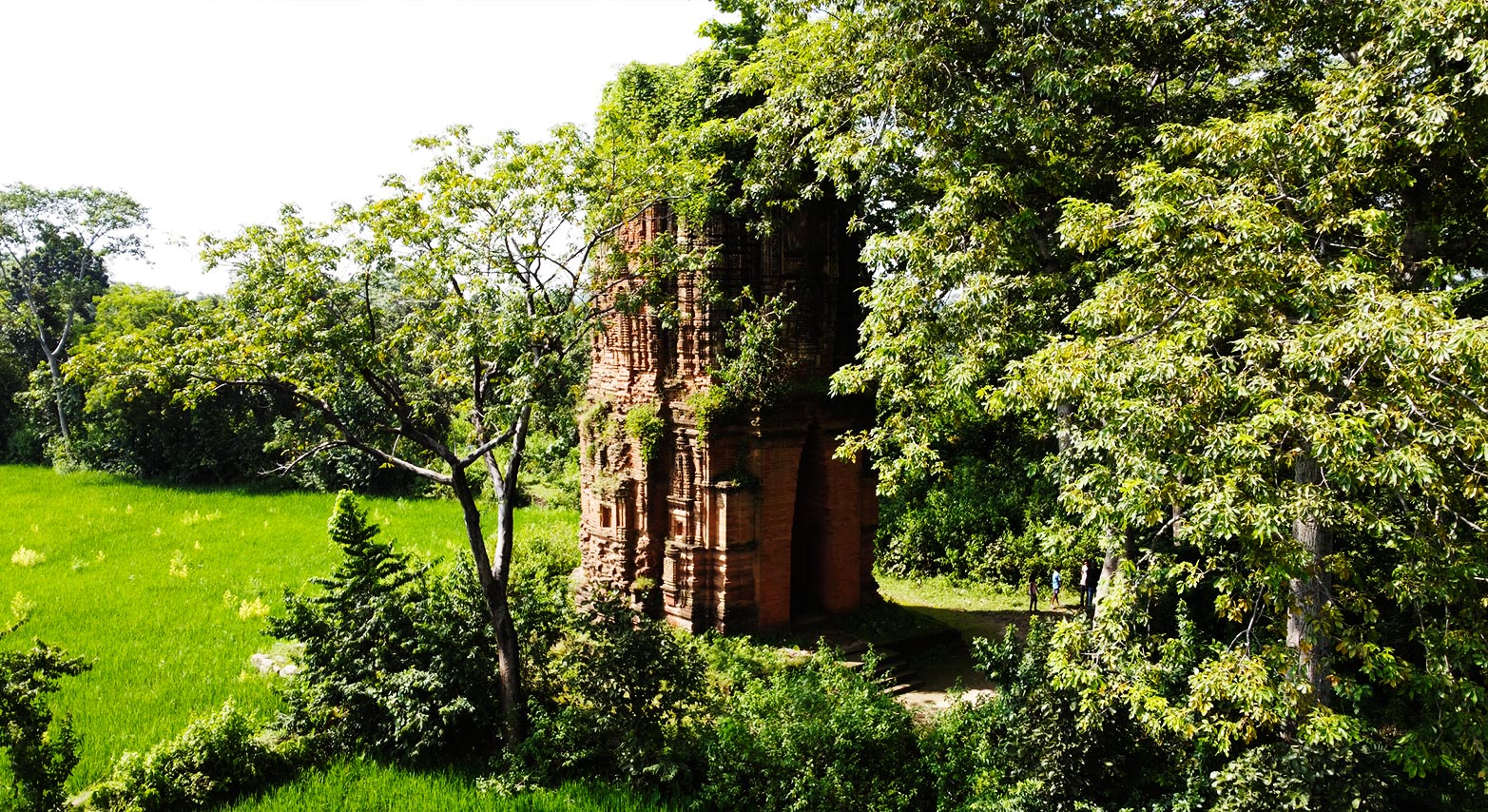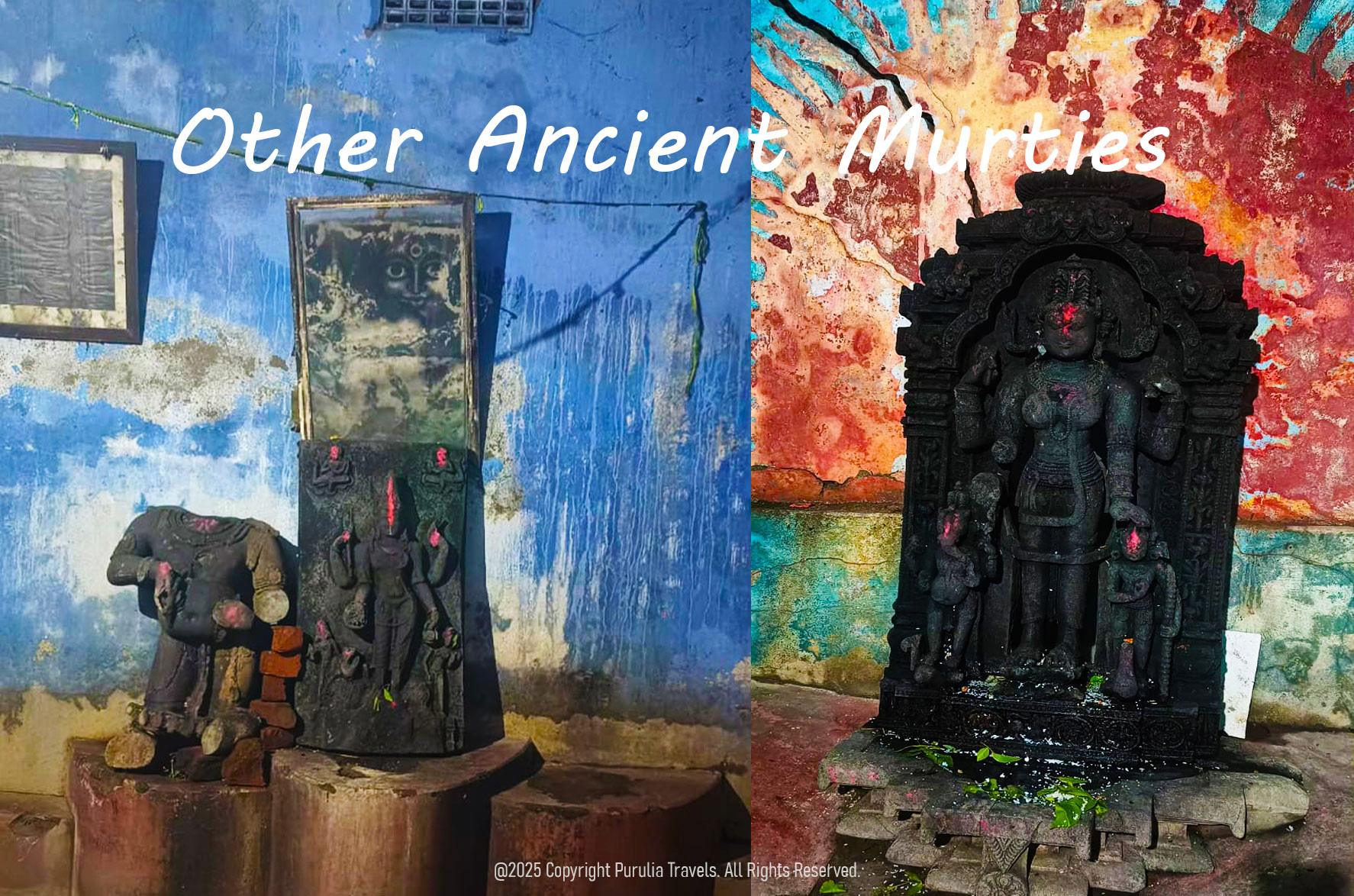












Tucked away in the Arsha block of Purulia district, Deulghata is a remarkable archaeological site that stands as a silent witness to the region’s glorious past. Rich with history, this ancient temple complex is a treasure trove of Jain and Hindu heritage, dating back to the Pala-Sena period.
Deulghata is most famous for its three towering brick duels (temples), adorned with intricate stucco decorations, floral motifs, and symbolic carvings that reflect the exquisite craftsmanship of early eastern Indian temple architecture. These structures beautifully capture the spiritual and artistic legacy of an era where Jain and Hindu traditions coexisted and flourished.
Adding to the site’s sanctity and mystery are several ancient murtis, including a 2,500-year-old Durga idol, along with other remarkable sculptures that hint at the region’s long-standing religious practices. A Shiva temple also stands at the site, further enriching Deulghata’s spiritual atmosphere.
What makes the experience even more magical is the river that flows gently beside the temple complex. Its presence creates a serene, picturesque setting—especially enchanting during sunrise or sunset when the ancient deuls cast long shadows over the glistening water. The sound of the Kasai river, the rustling trees, and the whispering winds all come together to transport visitors into a timeless realm.
Though time has weathered many parts of the site, the remaining structures are enough to captivate historians, travelers, and spiritual seekers alike. Deulghata is not just a destination—it’s a journey into the soul of Bengal’s rich cultural and architectural heritage.
Deulghata holds profound historical significance as a key center of Jainism in Purulia, especially during the 11th and 12th centuries, when the region was under the rule of the Pala and Sena dynasties. The site is renowned for its temples, which were dedicated to Jain Tirthankaras, offering a rare glimpse into the spiritual and religious life of that era. Despite the passage of time and the ruins that remain, the temples stand as enduring symbols of the region’s Jain heritage.
The intricate stucco decorations on the temples, including motifs of geese, floral designs, and figures associated with Pala-Sena art, are a testament to the advanced artistry of the time. These motifs blend Jain and Hindu symbolism, highlighting the cultural confluence that characterized the period. The architecture, with its graceful brickwork and decorative details, further emphasizes the significance of Deulghata as an important center of both religious and artistic heritage. This site provides a valuable connection to the region’s ancient past, showcasing the richness of the spiritual and artistic practices that once flourished here.

Deulghata’s temples are a remarkable example of ancient Pala-Sena architecture, showcasing intricate craftsmanship and a blend of Jain and Hindu influences.


The decline of Deulghata began after the temples were abandoned and left in disrepair, eventually falling into obscurity. It wasn’t until the mid-19th century that the site was rediscovered. British officials, including Colonel E.T. Dalton and archaeologist J.D. Beglar, played a key role in documenting the temples and shedding light on their historical and religious significance, particularly their ties to Jainism.
Despite the ravages of time, Deulghata’s temples remain a valuable archaeological site. The site continues to attract tourists and researchers, offering a glimpse into the rich spiritual and architectural heritage of the region. The rediscovery of Deulghata has helped preserve its importance as a cultural and historical landmark.
Winter is ideal for visiting Deulghata Temple, offering cool weather, serene surroundings, and great photo opportunities. During the Durga Puja, the 2,500-year-old Durga idol is worshipped, adding cultural depth. In spring, the area comes alive with vibrant Palash blooms, making it especially picturesque with red and orange colours.
During the monsoon, Deulghata Temple and its surroundings transform into a lush green paradise. The fresh rainfall enhances the natural beauty of the area, bringing out vibrant colors in the landscape. The weather becomes misty and cool, accompanied by the soothing sound of rainfall. On some days, low-hanging clouds float over the temple and surrounding hills, creating a mystical and enchanting atmosphere. This time is especially magical for nature lovers, offering a serene and unforgettable experience.
Summer is typically the least popular time to visit Deulghata Temple due to the heat and dry weather. However, early mornings and late evenings provide a more comfortable atmosphere, making it still possible to enjoy the beauty and spiritual tranquility of the temple. The summer months offer fewer crowds, allowing for a quieter, more introspective visit. Sitting beside the Kangsabati River during the early morning and evening hours adds a unique and serene experience that beautifully complements the temple's peaceful surroundings.
| Location Name | Details | Distance (Approx.) | Read More |
|---|---|---|---|
| Murguma Dam | Murguma Dam is a serene getaway in the Ajodhya Hills of Purulia, offering tranquil waters, lush forests, and scenic trekking trails for nature lovers. | 43.6 km | Read More |
| Suicide Point / Ukamburu | Ukamburu Hill, often called Suicide Point by visitors, this spot is known for its dramatic cliff edge marked by a large rock. It’s the perfect place to take in the stunning view of Murguma Dam and the beautiful landscape all around. | 45.1 km | Read More |
| Mayur Pahar | Mayur Pahar is a serene hill in Purulia, perfect for trekking, scenic views, and enjoying Palash blooms in spring. | 36.5 km | Read More |
| Ajodhya Hill Top | Ajodhya Hilltop is the vibrant gateway to the Ajodhya Hills, offering essential amenities, scenic beauty, and easy access to nearby attractions. | 42.9 km | Read More |
| Upper Dam | Upper Dam in Purulia is a scenic hydroelectric site with a floating solar plant, offering stunning views and peaceful surroundings in the heart of Ajodhya Hills. | 47.3 km | Read More |
Purulia Railway Station, located about 322 km from Kolkata, is well-connected by trains such as the Ranchi Vande Bharat Express (20898), Chakradharpur Express (18011), Purulia SF Express (12827), and Ranchi Intercity Express (18627). From the station, a private vehicle arranged by Purulia Travels will take you along the Purulia–Ranchi road and continue for 25 km until you reach Garhjoypur. From there, the vehicle will take a left and then continue about 5 km to reach Deulghata, located beside the Kasai River.
Purulia is well-connected by road to cities like Bankura, Asansol, Bokaro, Jamshedpur, and Ranchi. From Kolkata, you can take a government or private bus from Esplanade, including AC options. These buses will drop you at the Purulia Bus Stand, where a vehicle from Purulia Travels will pick you up. The vehicle will then take you along the Purulia–Ranchi road for about 25 km until you reach Garhjoypur. From there, it will take a left and continue for another 5 km to reach Deulghata, nestled beside the serene Kasai River.
The nearest airport is Birsa Munda Airport in Ranchi, about 117 km away, followed by Kazi Nazrul Islam Airport in Durgapur, around 164 km away. From either airport, you can take a train or bus to reach Purulia Town. Once there, a private vehicle from Purulia Travels will take you along the Purulia–Ranchi road for approximately 25 km until you reach Garhjoypur. The vehicle then takes a left and drives another 5 km to arrive at Deulghata, a tranquil site by the Kasai River.
Find quick answers to all your questions about visiting Deulghata
The temples at Deulghata are believed to be from the 11th-12th century, built during the Pala-Sena period.
While there are no facilities at Deulghata, nearby areas like Purulia town, Baghmundi, and Ajodhya Hills offer a variety of accommodations.
There are no entry fees to visit Deulghata, making it an ideal spot for budget travelers.
Subscribe to see secret deals prices drop the moment you sign up!
WhatsApp us

